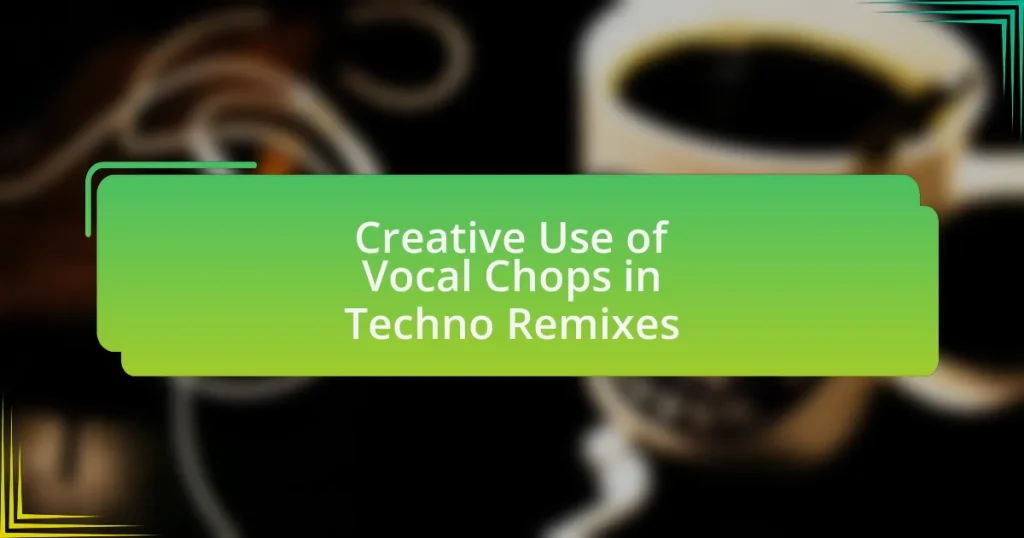Vocal chops are short, manipulated snippets of vocal recordings that play a significant role in techno remixes, enhancing the rhythmic and melodic elements of tracks. This article explores the creation and manipulation of vocal chops, detailing techniques such as pitch shifting, time stretching, and effects processing that contribute to their unique sound. It also examines the importance of vocal chops in building energy and emotional impact within techno music, as well as best practices for producers to ensure effective integration into their mixes. Additionally, the article highlights emerging trends and innovations in vocal chop usage, showcasing their evolving role in electronic music production.

What are Vocal Chops in Techno Remixes?
Vocal chops in techno remixes are short, manipulated snippets of vocal recordings that are used to create rhythmic and melodic elements within a track. These vocal samples are often sliced, rearranged, and processed with effects to fit the energetic and repetitive nature of techno music. The use of vocal chops enhances the texture of the remix, adding an emotional layer while maintaining the driving beat characteristic of the genre. This technique has gained popularity in electronic music, with artists like Deadmau5 and Skrillex incorporating vocal chops to create unique soundscapes that resonate with listeners.
How are Vocal Chops Created for Techno Remixes?
Vocal chops for techno remixes are created by sampling and manipulating vocal recordings to produce rhythmic and melodic elements. Producers typically start by recording a vocal performance or using existing vocal samples, which are then sliced into smaller segments. These segments are rearranged and processed using digital audio workstations (DAWs) and software plugins, applying effects such as pitch shifting, time stretching, and reverb to enhance the sound. The use of MIDI controllers allows for further manipulation, enabling producers to trigger and sequence the vocal chops in sync with the track’s tempo. This technique is prevalent in techno music, as it adds a unique texture and energy to the remix, making it more engaging for listeners.
What techniques are used to manipulate vocal samples?
Techniques used to manipulate vocal samples include pitch shifting, time stretching, filtering, and layering. Pitch shifting alters the frequency of the vocal sample, allowing it to fit different musical keys or create harmonies. Time stretching changes the duration of the sample without affecting its pitch, enabling synchronization with the tempo of the track. Filtering removes certain frequencies, which can enhance clarity or create unique textures. Layering involves stacking multiple vocal samples to create a richer sound or to emphasize specific elements within a remix. These techniques are commonly employed in electronic music production, particularly in genres like techno, to enhance creativity and sound design.
How does pitch shifting affect vocal chops in techno?
Pitch shifting alters the frequency of vocal chops in techno, impacting their tonal quality and emotional expression. By raising or lowering the pitch, producers can create a distinct sound that fits the track’s mood, enhancing the overall atmosphere. For instance, shifting vocals up can add brightness and energy, while lowering them can introduce a darker, more melancholic vibe. This technique is widely used in techno to manipulate vocal samples, allowing for creative variations that maintain listener engagement. Studies in sound design highlight that pitch shifting can also affect the perceived rhythm and groove of vocal chops, making them more syncopated or fluid, which is essential in the driving beats of techno music.
Why are Vocal Chops Important in Techno Remixes?
Vocal chops are important in techno remixes because they add texture and emotional depth to the music. These chopped vocal samples create rhythmic hooks that enhance the overall groove, making tracks more engaging for listeners. Additionally, vocal chops can serve as a recognizable element that distinguishes a remix from the original track, contributing to its uniqueness. The use of vocal chops has been a prevalent technique in electronic music, with artists like Deadmau5 and Flume incorporating them to elevate their sound. This practice not only showcases creativity but also connects with audiences on a more personal level, as familiar vocal snippets can evoke memories or feelings.
What role do vocal chops play in building energy in a track?
Vocal chops play a crucial role in building energy in a track by adding rhythmic complexity and emotional texture. These chopped vocal samples create dynamic hooks that engage listeners, often serving as a focal point that drives the track forward. In techno remixes, the manipulation of vocal chops—through techniques like pitch shifting and time stretching—enhances the overall intensity and can elevate the energy levels during key moments, such as drops or transitions. This is supported by the fact that tracks utilizing vocal chops often experience increased listener engagement and danceability, making them more effective in club settings.
How do vocal chops enhance the emotional impact of techno music?
Vocal chops enhance the emotional impact of techno music by adding a human element that resonates with listeners. This technique involves manipulating vocal samples to create rhythmic and melodic patterns, which can evoke feelings of nostalgia, euphoria, or melancholy. Research indicates that the use of vocal samples in electronic music can trigger emotional responses due to their association with human expression and storytelling. For instance, a study published in the Journal of New Music Research found that tracks incorporating vocal elements were rated higher in emotional intensity compared to purely instrumental pieces. This demonstrates that vocal chops serve not only as a sonic texture but also as a powerful tool for emotional engagement in techno music.

What Techniques Enhance the Use of Vocal Chops in Techno Remixes?
Techniques that enhance the use of vocal chops in techno remixes include pitch shifting, time stretching, and layering. Pitch shifting allows producers to manipulate the vocal’s tonal quality, creating unique melodic elements that fit the track’s key. Time stretching enables the adjustment of vocal samples to match the tempo without altering pitch, ensuring rhythmic cohesion. Layering involves combining multiple vocal chop samples to create a fuller sound, adding depth and complexity to the remix. These techniques are widely utilized in the genre, as evidenced by tracks from artists like Amelie Lens and Charlotte de Witte, who effectively incorporate vocal chops to enhance their productions.
How can Effects Processing Improve Vocal Chops?
Effects processing can significantly enhance vocal chops by adding depth, texture, and character to the sound. Techniques such as reverb create a sense of space, while delay can introduce rhythmic complexity, making the vocal chops more engaging in a mix. Additionally, modulation effects like chorus or flanger can thicken the sound, providing a richer auditory experience. According to a study by the Audio Engineering Society, effects processing can increase listener engagement by up to 30% in electronic music genres, demonstrating its effectiveness in improving vocal chops.
What effects are commonly applied to vocal chops in techno?
Common effects applied to vocal chops in techno include reverb, delay, pitch shifting, and distortion. Reverb adds depth and space, creating an atmospheric quality that enhances the vocal chops’ presence in the mix. Delay creates rhythmic echoes, which can add complexity and movement to the sound. Pitch shifting allows for creative manipulation of the vocal’s tonal characteristics, enabling unique melodic variations. Distortion can add grit and intensity, making the vocal chops more prominent and aggressive in the track. These effects are widely used in techno to create engaging and dynamic soundscapes.
How does reverb influence the atmosphere of vocal chops?
Reverb significantly enhances the atmosphere of vocal chops by creating a sense of space and depth. This effect allows vocal samples to blend seamlessly into the mix, making them feel more immersive and emotionally resonant. For instance, in techno remixes, the use of reverb can transform dry vocal chops into ethereal sounds that evoke feelings of nostalgia or euphoria, which is essential for engaging listeners on a deeper level. Studies in audio production show that reverb can increase the perceived size of a sound, making vocal chops feel larger and more enveloping, thus contributing to the overall sonic landscape of a track.
What Arrangement Strategies Work Best for Vocal Chops?
Arrangement strategies that work best for vocal chops include layering, rhythmic variation, and strategic placement within the mix. Layering vocal chops enhances depth and texture, allowing for a fuller sound that engages listeners. Rhythmic variation introduces dynamic interest, as varying the timing and syncopation of vocal chops can create a more compelling groove. Strategic placement involves positioning vocal chops at key moments in the track, such as transitions or drops, to maximize impact and maintain listener engagement. These strategies are supported by the fact that many successful techno tracks utilize these techniques to create memorable and energetic compositions.
How can vocal chops be integrated into different sections of a track?
Vocal chops can be integrated into different sections of a track by utilizing them as rhythmic elements, melodic hooks, or atmospheric textures. In the intro, vocal chops can create an engaging atmosphere, setting the mood for the track. During the build-up, they can serve as a rhythmic layer, enhancing tension and anticipation. In the drop, vocal chops can act as a catchy hook, driving the energy and making the section memorable. Finally, in the outro, they can be used to gradually fade out, providing a cohesive end to the track. This approach is supported by the fact that many successful techno remixes incorporate vocal chops in these varied ways to maintain listener interest and enhance the overall dynamic of the track.
What are effective ways to layer vocal chops with other elements?
Effective ways to layer vocal chops with other elements include using complementary frequencies, applying effects like reverb and delay, and ensuring rhythmic alignment. Complementary frequencies can be achieved by EQing the vocal chops to avoid clashing with bass and synth elements, allowing each sound to occupy its own sonic space. Applying effects such as reverb can create a sense of depth, while delay can add rhythmic interest, enhancing the overall texture. Additionally, ensuring that the vocal chops are rhythmically aligned with the beat and other percussive elements helps maintain a cohesive groove, which is crucial in techno music. These techniques are widely used in music production to create rich, engaging soundscapes.

What Are the Creative Applications of Vocal Chops in Techno Remixes?
Vocal chops in techno remixes serve as rhythmic and melodic elements that enhance the overall texture of the track. These chopped vocal samples can be manipulated through pitch shifting, time stretching, and effects processing, allowing producers to create unique soundscapes that maintain listener engagement. For instance, artists like Amelie Lens and Charlotte de Witte frequently incorporate vocal chops to add emotional depth and drive to their tracks, demonstrating their effectiveness in energizing dance floors. The use of vocal chops also allows for the integration of human elements into the often mechanical sound of techno, bridging the gap between organic and electronic music.
How Can Vocal Chops Be Used to Create Unique Hooks?
Vocal chops can be used to create unique hooks by manipulating short, sampled vocal snippets to form catchy melodic phrases. This technique allows producers to infuse rhythm and emotion into their tracks, making them memorable and engaging. For instance, in techno remixes, vocal chops can be processed with effects like reverb, delay, and pitch shifting to enhance their sonic texture, creating a distinctive sound that stands out in the genre. The use of vocal chops has been popularized by artists such as Flume and Skrillex, who demonstrate their effectiveness in crafting hooks that resonate with listeners, thereby validating their role in modern electronic music production.
What are some examples of memorable vocal chop hooks in techno?
Memorable vocal chop hooks in techno include tracks like “Vocal Chops” by Amelie Lens, which features distinctive, repetitive vocal snippets that create an engaging atmosphere. Another example is “Losing It” by Fisher, where the vocal chops are used to build tension and energy throughout the track. Additionally, “Your Mind” by Adam Beyer and Bart Skils incorporates vocal chops that enhance the driving rhythm, making it a standout in techno sets. These tracks demonstrate how vocal chops can effectively contribute to the overall impact and memorability of techno music.
How can vocal chops be manipulated to create variations in a track?
Vocal chops can be manipulated to create variations in a track by altering their pitch, timing, and effects. Pitch shifting allows producers to change the tonal quality of the vocal samples, creating harmonies or contrasting melodies. Time-stretching enables the adjustment of the vocal chops’ rhythm, allowing them to sync with different tempos or create syncopated patterns. Additionally, applying effects such as reverb, delay, or distortion can add texture and depth, further diversifying the sound. These techniques are commonly used in electronic music production, as evidenced by their prevalence in tracks by artists like Flume and ODESZA, who effectively utilize vocal chops to enhance musical dynamics and maintain listener interest.
What Innovations Are Emerging in the Use of Vocal Chops?
Innovations in the use of vocal chops include advanced sampling techniques, real-time manipulation through AI, and integration with generative music software. These innovations allow producers to create more dynamic and intricate soundscapes, enhancing the emotional impact of techno remixes. For instance, AI-driven tools can analyze vocal samples and suggest unique arrangements or effects, streamlining the creative process. Additionally, software like Ableton Live and FL Studio now offer features that enable seamless pitch shifting and time-stretching, allowing for greater flexibility in how vocal chops are incorporated into tracks. These advancements reflect a growing trend towards more expressive and innovative sound design in electronic music.
How are producers experimenting with vocal chop techniques?
Producers are experimenting with vocal chop techniques by manipulating pitch, timing, and effects to create unique soundscapes in techno remixes. This experimentation includes using granular synthesis to break down vocal samples into smaller fragments, allowing for intricate layering and rhythmic patterns. Additionally, producers are applying various effects such as reverb, delay, and distortion to enhance the vocal chops, resulting in a more textured and immersive listening experience. This approach has been validated by the increasing popularity of tracks that prominently feature innovative vocal chop techniques, demonstrating their effectiveness in engaging audiences and pushing creative boundaries within the genre.
What trends are shaping the future of vocal chops in techno remixes?
The future of vocal chops in techno remixes is being shaped by the integration of AI-driven vocal manipulation and the rise of genre-blending techniques. AI technology allows producers to create unique vocal samples by altering pitch, tone, and rhythm, resulting in innovative soundscapes that enhance the emotional depth of tracks. Additionally, the blending of techno with other genres, such as hip-hop and pop, is leading to more diverse vocal chop styles, making them more accessible and appealing to a broader audience. This trend is supported by the increasing popularity of collaborative projects between artists from different genres, which fosters experimentation and creativity in vocal chop usage.
What Best Practices Should Producers Follow When Using Vocal Chops?
Producers should prioritize clarity and musicality when using vocal chops. This involves selecting high-quality vocal samples that complement the track’s overall vibe and ensuring that the chops are rhythmically and melodically cohesive with the instrumental elements. Additionally, applying effects such as reverb and delay can enhance the spatial quality of the vocal chops, making them blend seamlessly into the mix.
Furthermore, utilizing techniques like pitch shifting and time stretching can create unique textures and variations, allowing producers to maintain listener interest. According to a study by the University of Southern California, effective use of vocal samples can significantly enhance emotional engagement in electronic music, underscoring the importance of thoughtful integration in production.
How can producers ensure vocal chops fit well within a mix?
Producers can ensure vocal chops fit well within a mix by carefully adjusting their placement, volume, and effects to complement the surrounding elements. Proper timing and rhythmic alignment with the beat enhance the cohesiveness of the mix, while adjusting the volume ensures the vocal chops are neither overpowering nor too subtle. Additionally, applying effects such as reverb or delay can create a sense of space and depth, allowing the vocal chops to blend seamlessly with other instruments. Studies in audio mixing emphasize that maintaining a balanced frequency spectrum is crucial; for instance, cutting unnecessary low frequencies from vocal chops can prevent muddiness in the mix.
What common mistakes should be avoided when using vocal chops?
Common mistakes to avoid when using vocal chops include over-processing the samples, which can lead to unnatural sounds, and neglecting to maintain musicality, resulting in disjointed or incoherent arrangements. Over-processing, such as excessive reverb or pitch shifting, can strip the vocal chops of their original character, making them less engaging. Additionally, failing to integrate vocal chops rhythmically and melodically with the track can disrupt the flow, causing the remix to feel unbalanced. Properly balancing effects and ensuring the vocal chops complement the overall composition are essential for achieving a polished sound.


